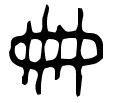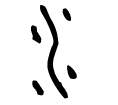About ten years ago, I taught Chinese in a Chinese school in New Jersey. There was a 11 years old, left-handed girl in my class, let me call her R. I taught students to write shell bone script, they didn’t have problem. I then taught them big seal, small seal script, they didn’t have problem too. Because all those scripts are lines with the same width, similar to English, easy to write.
Next, I taught them to write clerical script.
All right-handed students had no problem to write it with brush. However, R had trouble to write it because the strokes are not all straight and same width, especially the right-falling stroke in the lower part of the right side, which is the most typical stroke of clerical script “蚕头燕尾” (silkworm head and swallowtail). Character Wood has no silkworm head, but swallowtail, which has the widest part near the right end with a round end. The stroke is a narrow – widen – narrow from the up-left to down-right.
Right-handed could draw it by gradually pressing down the brush when pulling the brush first then rise it up gradually to the right bottom corner. However, R, left-handed, had to push the brush down and forward to the right bottom corner. The brush is soft, difficult to control when you push it forward and rise it up gradually to get a round stroke end.
It is completely different from the writing English letters with pen, the strokes of letters are all the same width, left-handed could pull the pen from left to right without problem. When you use soft brush to write stroke width not consistent, the difficulty is too high to overcome.
I had not realized the problem until I saw her struggle in clerical script. I suggested her write with right hand, but she didn’t want to. She kept struggling to end of the semester, didn’t come back next semester. However, her elder sister, right-handed, was the best student in the class, won multiple first prize in Chinese calligraphy competitions.
I started to think “Were Chinese characters created by right-handed?”. Why are the characters easy for right-handed, but difficult for left-handed? Why don’t we hear any famous left-handed calligrapher in Chinese history?
I had the thought for long time but never started to do the research until recently. I searched some shell bone script, bronze script, big or small seal script, and clerical script, tried to find some clue in this field.
The following is my summary of my research.
Shell bone script (~ 3500 + years ago) strokes are lines, the strokes are no changes in thickness, which are same as English letters. It is easy for left-handed to write even with soft brush.
However, we can see that the character Again is a side view of a right hand, which is easier for right-handed to draw, a little bit more difficult for left-handed.
Bronze, and big seal scripts (~ 3000 + years ago) are similar, strokes have a little bit change in thickness, some curves, still easy to left-handed.
Small seal script (~ 2200 years ago) is more restrict on line width, the strokes are no changes in thickness, easier to write for both handed.
Clerical script (~2000 years ago) has changes in stroke thickness, sometimes very big.
Let’s see the character Again, the one on the far left. The falling-right stroke, the thickness on the right bottom end is much wider than that on the left up. The third character Mountain has the long horizontal stroke, the right end is the widest part of the stroke. Also, the far right one, character Compete, the right bottom curve is the widest part of the character. The right-handed could press the brush down hard while pull the brush to right or right downward, then gradually lose the pressure while pull the brush out. However, the left-handed can only push the brush to right or right downward, can’t get the tips of the end of strokes because the brush hair is bent backward.
Therefore, we can see that the clerical script was created by right-handed, and for the right-handed.
Now, you may ask if other scripts were created by right-handed?
Let’s see the following characters.
Shell bone script, from left to right: Water, Friend, Father, and Eye.
The three characters on the left have big stroke(s) falling right down, the character Eye has right up strokes. All the strokes are easy for right-handed to draw. However, it is still not strong enough to say “The shell bone script was created by right-handed”.
I think that the best evidence are the following characters.
From left to right, Brush (shell bone script), Write (shell bone script), Brush (big seal script)
The middle of all three is brush, the right up is hand, right hand holding the brush. The right one three fingers are across the shaft.
We are confident to say that the shell bone, big seal scripts were created by right-handed too. Bronze script is very similar to shell bone and big seal scripts. The small seal script is very similar to big seal script. So, all the old scripts were created by right-handed.
In Chinese history, there has never been a famous calligraphist who is left-handed, all famous calligraphists in Chinese history are right-handed, which is another strong evidence to support my claim “Chinese characters were created by right-handed”.
The reason of above fact is that you can’t write or draw Chinese characters with soft brush by left hand, which is different from writing English with hard pen. If you don’t believe what I said, just buy a brush on Amazon, and try to write English letters with the brush by left hand, you will find how difficult to do so.
Note: Update information
1, Amazing Chinese Characters blog has changed name to Learn Chinese with Pictography, and changed its URL address too, the new URL is
Learn Chinese with Pictography.blogspot.com/
2, Pictographic Chinese Calligraphy blog has changed name to Chinese Pictographic Calligraphy, and the new URL is
Chinese Pictographic Calligraphy.blogspot.com/
You are welcome to access the new sites for Chinese learning. Please update your bookmarks.




























